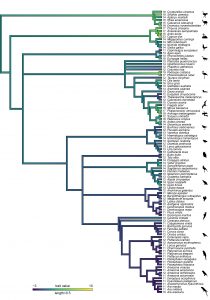Hot off the press! First AVINECK publication
By Christine Böhmer on Thursday, May 2 2019, 12:12 - News - Permalink
 In our publication (Böhmer et al. 2019 Royal Society Open Science), we analyzed more than 100 extant bird taxa in order to provide new insights into the evolution of the vertebral formulae and the scaling relationships between skeletal dimensions and body size.
In our publication (Böhmer et al. 2019 Royal Society Open Science), we analyzed more than 100 extant bird taxa in order to provide new insights into the evolution of the vertebral formulae and the scaling relationships between skeletal dimensions and body size.The neck of birds has always been regarded as a classic example of high variability in the number of vertebrae ranging from ten cervical vertebrae in parrots to 26 cervical vertebrae in swans. And it seems that the avian clade includes many long-necked taxa. However, cervical count is not necessarily a determinant of neck length since many relatively short vertebrae may form an equally long neck as few relatively long vertebrae. Furthermore, the wide array of small to very large species makes it difficult to evaluate actual neck length.

We addressed this issue by investigating the evolution of the vertebral formulae and the scaling relationships between skeletal dimensions and body size in a phylogenetically and ecologically broad sample of birds. In our publication (Böhmer et al. 2019 Royal Soc. Open Sci), we investigated a total of 103 extant adult avian species comprising 34 orders and 68 families sampled from the bird collection of the Muséum National d’Histoire Naturelle (MNHN) in Paris. The total number of cervical vertebrae for each specimen was identified and a number of morphometric measurements on the vertebrae and the three leg bones of the hindlimb have been taken.

This work is also part of the master's thesis by Avineck student Olivia Plateau.
References:
Böhmer C, Plateau O, Cornette R and Abourachid A (2019). Correlated evolution of neck length and leg length in birds. Royal Society Open Science 6: 181588. DOI: 10.1098/rsos.181588.
 Follow @ANR_Avineck
Follow @ANR_Avineck